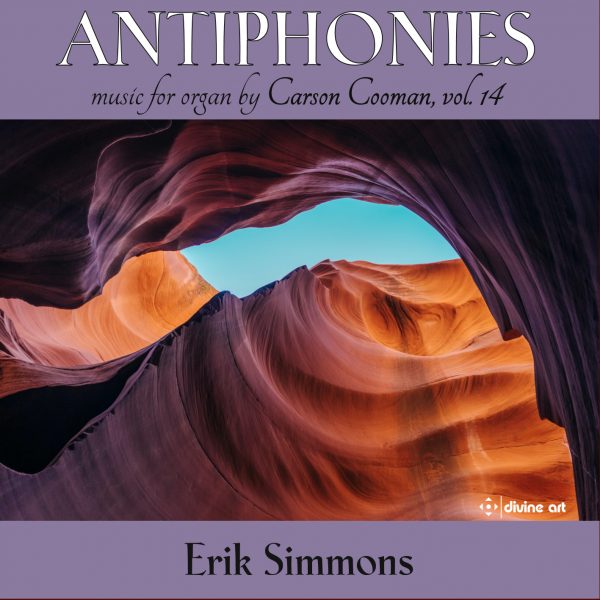Fanfare
This is Volume 14 in the ongoing series of discs of Carson Cooman’s organ music, performed as usual by Erik Simmons. I have reviewed about half of the total, mostly positively, and this one also goes on the plus side of the ledger. All of these pieces were composed between 2013 and 2020.
Fantasia canonica was written for the installation of Charissa Simmons as Canon for Children and Families at the Episcopal Church cathedral in Portland, [Oregon]. (It is not said if she is any relation to Erik Simmons, though a joint commission by them mentioned elsewhere in the notes suggests that they are.) The theme of the piece is derived from conversion of letters in the dedicatee’s name to corresponding musical notes. (Fellow Fanfare critic, friend, and composer David DeBoor Canfield wrote a piece for my wedding in 2005 that derived its theme using the same technique.) The piece has an air of stately but celebratory gravitas. Two from the British Isles employs an easily recognizable pair of well-known hymn tunes, “Kingsfold” and “Hyfrydol,” as thematic bases for a prelude and postlude to a church service; the former is more contemplative, the latter rather energetic, as if to propel parishioners out of their pews. Three Autumn Sketches after a Watercolor by Maria Willscher is, as the title indicates, cast in three movements, titled “Herbststimmung” (Autumn Mood), “Herbstfarben” (Autumn Colors), and “Sonnenuntergang” (Sunset). The lovely watercolor in question is thoughtfully reproduced in the booklet. (While again there is no information provided, I presume that Maria Willscher was related to—perhaps the mother of—Cooman’s colleague and friend, Andreas Willscher, whose works I have also reviewed in these pages.) All three movements are slow-moving, meditative, and subdued; but I wish to single out Sonnenuntergang as an absolutely gorgeous, deeply moving, prayerful piece, one for which the cliched remark “I want that played at my funeral!” would be completely appropriate. This brings us to my one regret regarding this disc: The mood is rudely broken by the loud, dissonant opening chord of the next work on the program, A St. Patrick Silhouette. A different ordering of the contents of this disc to avoid such a jarring jolt would have been far more appropriate. (I suppose that’s why the “program tracks” function on a CD player exists.) The piece itself, which is divided into several distinct sections, is effective enough in suggesting the turmoil of the saint’s life, though it is not one of my favorites in Cooman’s oeuvre.
The disc gets back on track for me with St. Michael Antiphonies, which belies its title by being a delightfully tuneful work with a lively, jumping dance theme. Desert Marigold offers an oasis of botanic stillness, as if one were watching the flower slowly unfold (or better, refold) against a gradually encroaching twilight background. Prelude del ricordo (Prelude of Remembrance), according to Cooman, “was thought of in reference to the numerous lives lost during the COVID-19 pandemic.” If that description suggests something quiet and contemplative, think again; most of the piece is dramatically assertive. To my ears, it does not suggest anger, but rather a steely determination that those lost should not be forgotten, but vividly remembered and treasured.
The closing work, Suite circulaire, is another triptych, with movements titled “Praeludium,” “Ricercare,” and “Toccata.” Cooman states that his objective in crafting this suite was to take “a free, contemporary approach to the historical genre of ‘circulating’ (or modulating) compositions, where the basic material moves through a variety of keys before returning ‘home’ again. The goal is not simply to play a modulation ‘game,’ but rather to construct a true musical discourse where the varied keys are an essential part of the concept.” This is the other work on this disc that I find to be less than a complete success. In the first movement, a grupetto-like four-note motif is repeated far too often for its own good; if Cooman were to cut the length of the movement by about a third, he would greatly strengthen it. I have no criticisms of the other two movements; the “Ricercare” provides a quiet interlude, and the “Toccata” a predictably vigorous, even violent, virtuoso finger- and foot-busting closer. As before, Erik Simmons presents Cooman’s works in the best possible light. The instrument, at the Propsteikirche St Ludgerusin Billerbeck, Germany, was recorded remotely using the Hauptwerk system employed on several previous releases in this series. It is a modem instrument, constructed by Orgelbau Fleiter in 2014; it definitely has a modem sound palette rather than one of a German Baroque or Romantic organ, but one that is not unattractive. Anyone who has been collecting this series of discs will definitely want this one as well; it is worth the price for the Sonnenuntergang alone. Recommended.
@divineartrecordingsgroup
A First Inversion Company
Registered Office:
176-178 Pontefract Road, Cudworth, Barnsley S72 8BE
+44 1226 596703
Fort Worth, TX 76110
+1.682.233.4978












